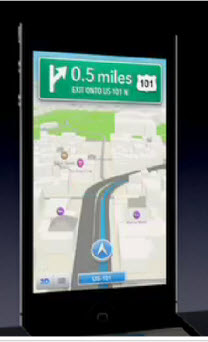Apple just entered -- and quite possibly killed -- another market

During the announcements coming from the Apple WWDC -- WorldWide Developer Conference -- 2012 keynote speech yesterday, I was keeping an eye on what effect the new hardware and software would have on existing markets.

Now, on the face of it, maps might not seem either all that sexy or disruptive, but the mapping platform built into the iPhone and iPad is quite a core feature that's leveraged throughout the platform. By replacing Google's mapping service with its own -- using data from companies such as TomTom and OpenStreetMaps and others -- Apple is putting itself at the center of the action.
However, there was more to the mapping announcement than just a change of provider. Apple also unveiled a new and highly requested feature -- turn-by-turn navigation. This is where the new mapping app starts to become disruptive.
By adding turn-by-turn navigation to iOS, Apple is allowing the iPhone and iPad to be used as in-car GPS systems right out of the box. Previously, the mapping app didn't offer the turn-by-turn navigation, and this meant that users had to purchase third-party apps to add this feature. This is no longer the case, and this has significant implications for the entire in-car GPS market.
And by implications, I mean casualties. And those casualties will be companies that sell in-car GPS receivers, companies such as TomTom and Garmin.
Apple sells millions of iPhones and iPads every quarter, and these people no longer need to buy a secondary device to get them from A to B. Yes, they might need a mount for their iPhone or iPad, and possibly a car cord for keeping it charged, but these two items are going to come in a lot cheaper than buying an entire in-car GPS unit.
In addition, vendors such as TomTom and Garmin also earn a significant revenue from selling annual map updates. iOS users will save money here because the maps will not need updating because Apple will be handling that at their end. This saves the owner a significant chunk of change, and will hurt the bottom line of the in-car GPS vendors.
But that's not all. The existing GPS vendors are going to get hit a third way. All the big names have apps which replicate their in-car GPS hardware experience on the iPhone or iPad. The business model for these apps replicate that of the hardware, in that the customer has to make an initial investment for the app, and then pay a fee for extras such as map updates and traffic information. iPhone and iPad owners would be crazy to be hemorrhaging this sort of money on a yearly basis to the likes of Garmin and TomTom when their iOS device offers similar functionality at no cost.
I'm not saying that there's no longer a market for dedicated in-car GPS receivers. Some people will always favor a dedicated device to a convergence device. It's the same reason you see people walking around with an iPhone but still using a compact camera to take photos.
Problem is, with iOS 6, Apple will put an in-car GPS receiver into the hands of millions of people, and that is going to have a very serious effect on the in-car GPS market. In some ways, TomTom has been fortunate, and maneuvered itself into an advantageous position by licensing maps to Apple, but it's unlikely that this will offset the negative effect from lost hardware, map upgrade and app sales.
A year from now the in-car GPS landscape is likely to be a very different place.
Image source: Apple.
Related:
- TomTom enters map agreement with Apple
- Apple CEO Cook: Ultrabooks are pretenders
- Apple granted MacBook Air design patent; problems ahead for Ultrabook makers?
- Possible iPhone 5 chassis appears on video
- Why chip names tell us very little about the iPhone 5
- Do these blueprints show the iPhone 5?
- iPhone 5 could feature a "Retina display killer" screen
- Apple's Tim Cook appears to ‘rules out' iPhone 5 with 4-inch screen
- Reuters: iPhone 5 to have 4-inch screen
- WSJ: iPhone 5 getting 4-inch+ screen
- Best earphones for your iPhone and iPad